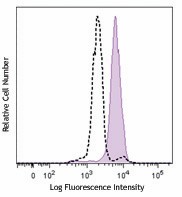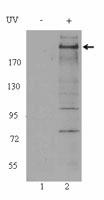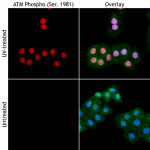- Clone
- 10H11.E12 (See other available formats)
- Regulatory Status
- RUO
- Other Names
- Ataxia telangiectasia mutated (ATM) kinase, serine-protein kinase, AT mutated
- Isotype
- Mouse IgG1, κ

-

Etoposide-treated, HeLa cells were treated with FOXP3 Fix/Perm Buffer Set and then intracellularly stained with anti-human/mouse ATM Phospho (Ser1981) (clone 10H11.E12) PE (filled histogram). Open histogram represents the staining with untreated HeLa cells.
| Cat # | Size | Price | Quantity Check Availability | ||
|---|---|---|---|---|---|
| 651203 | 25 µg | $177.00 | |||
| 651204 | 100 µg | $372.00 | |||
Ataxia telangiectasia mutated kinase (ATM) is a serine/threonine kinase that regulates cell cycle checkpoints and DNA repair. ATM is held inactive in unirradiated cells as a dimer or higher-order multimer. Cellular irradiation induces rapid intermolecular autophosphorylation of serine 1981 that causes dimer dissociation and initiates cellular ATM kinase activity. ATM kinase regulates a number of proteins involved in cell cycle checkpoint control, apoptosis, and DNA repair, including tumor suppressor proteins p53 and BRCA1, checkpoint kinase CHK2, checkpoint proteins RAD17 and RAD9, and DNA repair protein NBS1. Mutations in the corresponding ATM gene result in ataxia telangiectasia (AT), an autosomal recessive disease characterized by uncoordinated muscle movement and neurodegeneration. Cells from AT patients display defective DNA damage-induced checkpoint activation, sensitivity to radiation, and a higher frequency of chromosome breakage.
Product Details
- Verified Reactivity
- Human, Mouse
- Antibody Type
- Monoclonal
- Host Species
- Mouse
- Immunogen
- KLH conjugated synthetic peptide SLAFEEGSpQSTTISS
- Formulation
- Phosphate-buffered solution, pH 7.2, containing 0.09% sodium azide.
- Preparation
- The antibody was purified by affinity chromatography and conjugated with PE under optimal conditions.
- Concentration
- 0.2 mg/ml
- Storage & Handling
- The antibody solution should be stored undiluted between 2°C and 8°C, and protected from prolonged exposure to light. Do not freeze.
- Application
-
ICFC - Quality tested
- Recommended Usage
-
Each lot of this antibody is quality control tested by intracellular immunofluorescent staining with flow cytometric analysis. For flow cytometric staining, the suggested use of this reagent is ≤0.125 µg per million cells in 100 µl volume. It is recommended that the reagent be titrated for optimal performance for each application.
- Excitation Laser
-
Blue Laser (488 nm)
Green Laser (532 nm)/Yellow-Green Laser (561 nm)
- Application Notes
-
Patent No. USA: 7,108,992
- Product Citations
-
- RRID
-
AB_2562654 (BioLegend Cat. No. 651203)
AB_2562654 (BioLegend Cat. No. 651204)
Antigen Details
- Structure
- 3056 amino acids, 350 kD.
- Distribution
-
Primarily nuclear, also found in endocytic vesicles.
- Function
- Serine/threonine protein kinase which activates checkpoint signaling upon double strand breaks (DSBs), apoptosis, and genotoxic stresses such as ionizing ultraviolet A light (UVA), thereby acting as a DNA damage sensor.
- Biology Area
- Cell Biology, Chromatin Remodeling/Epigenetics, Transcription Factors, Ubiquitin/Protein Degradation
- Molecular Family
- Phospho-Proteins
- Antigen References
-
1. Lee JH and Paull TT 2007. Oncogene 26:7741.
2. Bakkenist CJ and Kastan MB 2003. Nature 421:499.
3. McConville CM, et al. 1996. Am. J. Hum. Genet. 59:320.
4. Tang X, et al. 2008. Mol. Cell Biol. 28:2559.
- Gene ID
- 472 View all products for this Gene ID
- UniProt
- View information about ATM on UniProt.org
Other Formats
View All ATM Reagents Request Custom Conjugation| Description | Clone | Applications |
|---|---|---|
| Purified anti-ATM Phospho (Ser1981) | 10H11.E12 | WB,ICC |
| PE anti-ATM Phospho (Ser1981) | 10H11.E12 | ICFC |
Compare Data Across All Formats
This data display is provided for general comparisons between formats.
Your actual data may vary due to variations in samples, target cells, instruments and their settings, staining conditions, and other factors.
If you need assistance with selecting the best format contact our expert technical support team.
-
Purified anti-ATM Phospho (Ser1981)

Hela cell extracts were resolved by electrophoresis, transfe... 
HeLa cells were stained with purified anti-ATM Phospho (Ser ... -
PE anti-ATM Phospho (Ser1981)

Etoposide-treated, HeLa cells were treated with FOXP3 Fix/Pe...
